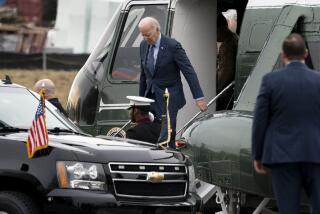First Lady’s Secrets Are in the Dock : A trial date is set on a suit to disclose who decided what at closed health-care meetings.
- Share via
Last Monday, U.S. District Judge Royce C. Lamberth ordered First Lady Hillary Rodham Clinton and her top health-care aide, Ira Magaziner, to stand trial Sept. 12 on civil charges of covering up the involvement of special interests in drafting the Clinton health care plan.
The specific legal issues before the bench are whether the First Lady’s health-reform task force violated the Federal Advisory Committee Act by holding meetings in secret, and whether Magaziner perjured himself when he testified under oath in March, 1993, that only federal employees were involved in the secret meetings.
The issues before the public are more important. They involve the First Lady’s candor, or lack thereof, and the White House’s cynical manipulation of the public’s health concerns in order to benefit special interests allied with the Clintons.
The Federal Advisory Committee Act requires task forces not wholly composed of federal employees to meet in public. When pressed by the Assn. of American Physicians and Surgeons to comply with the law and open the meetings, Clinton and her aides claimed that only federal employees were involved in the work of the task force.
This claim disintegrated when Kent Masterson Brown, attorney for the physicians’ group, presented Judge Lamberth with 37 pounds of evidence that 357 members of the task force were not federal employees.
Under pressure of the evidence, Clinton’s Justice Department lawyers abandoned the federal-employees-only defense. The new defense of the secret meetings is that the health-care task force did not influence, and was not intended to influence, the content of President Clinton’s health-care reform plan. If the task force was not established by the President or utilized by him to obtain advice or recommendations, it is not covered by the Federal Advisory Committee Act.
What are we to make of the President’s publicly expressed appreciation to the task force for its contribution to his health-care plan if the work of the task force was not utilized by the President? Even more puzzling is Magaziner’s staffing memo of Jan. 26, 1993, a copy of which is in the judge’s hands. The memo clearly states that the goal of the task force “is to prepare comprehensive health-care reform legislation in the next 100 days.”
The First Lady, Magaziner and their Justice Department lawyers are driven to implausible argument by a desperate need to keep the public from finding out about the special-interest groups that prepared the Clinton health-care plan.
If the plaintiffs win the lawsuit, the secret proceedings of the task force will be made public. The opened files will expose the President and First Lady to charges of public deception that will make Richard Nixon’s transgression look mild in comparison. Hidden behind the President’s promise of “universal coverage” paid for by employers and the federal government, special interests were working feverishly devising a scheme that would drive doctors out of private practice, terminate “fee for service” insurance coverage, curtail the supply of medical specialists and herd the public into impersonal, bureaucratic health-care organizations that would save money by rationing medical services.
Among the lawsuits and investigations that threaten the Clinton presidency, there are no greater dangers than the secret files of the health-care task force, which will reveal a cynical President defrauding the public in behalf of special interests.
More to Read
Sign up for Essential California
The most important California stories and recommendations in your inbox every morning.
You may occasionally receive promotional content from the Los Angeles Times.













